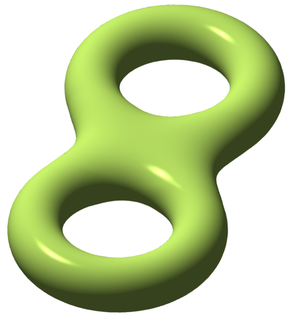In mathematics, K-theory is, roughly speaking, the study of a ring generated by vector bundles over a topological space or scheme. In algebraic topology, it is a cohomology theory known as topological K-theory. In algebra and algebraic geometry, it is referred to as algebraic K-theory. It is also a fundamental tool in the field of operator algebras. It can be seen as the study of certain kinds of invariants of large matrices.
The Riemann–Roch theorem is an important theorem in mathematics, specifically in complex analysis and algebraic geometry, for the computation of the dimension of the space of meromorphic functions with prescribed zeroes and allowed poles. It relates the complex analysis of a connected compact Riemann surface with the surface's purely topological genus g, in a way that can be carried over into purely algebraic settings.
In algebraic geometry, a branch of mathematics, Serre duality is a duality present on non-singular projective algebraic varieties V of dimension n. It shows that a cohomology group Hi is the dual space of another one, Hn−i.
In mathematics, complex multiplication (CM) is the theory of elliptic curves E that have an endomorphism ring larger than the integers; and also the theory in higher dimensions of abelian varieties A having enough endomorphisms in a certain precise sense. Put another way, it contains the theory of elliptic functions with extra symmetries, such as are visible when the period lattice is the Gaussian integer lattice or Eisenstein integer lattice.
In mathematics, especially in algebraic geometry and the theory of complex manifolds, coherent sheaves are a class of sheaves closely linked to the geometric properties of the underlying space. The definition of coherent sheaves is made with reference to a sheaf of rings that codifies this geometric information.
In mathematics, Kähler differentials provide an adaptation of differential forms to arbitrary commutative rings or schemes. The notion was introduced by Erich Kähler in the 1930s. It was adopted as standard in commutative algebra and algebraic geometry somewhat later, once the need was felt to adapt methods from calculus and geometry over the complex numbers to contexts where such methods are not available.
In mathematics, a gerbe is a construct in homological algebra and topology. Gerbes were introduced by Jean Giraud following ideas of Alexandre Grothendieck as a tool for non-commutative cohomology in degree 2. They can be seen as a generalization of principal bundles to the setting of 2-categories. Gerbes provide a convenient, if highly abstract, language for dealing with many types of deformation questions especially in modern algebraic geometry. In addition, special cases of gerbes have been used more recently in differential topology and differential geometry to give alternative descriptions to certain cohomology classes and additional structures attached to them.
In mathematics, the Chern–Weil homomorphism is a basic construction in Chern–Weil theory that computes topological invariants of vector bundles and principal bundles on a smooth manifold M in terms of connections and curvature representing classes in the de Rham cohomology rings of M. That is, the theory forms a bridge between the areas of algebraic topology and differential geometry. It was developed in the late 1940s by Shiing-Shen Chern and André Weil, in the wake of proofs of the generalized Gauss–Bonnet theorem. This theory was an important step in the theory of characteristic classes.
In contexts including complex manifolds and algebraic geometry, a logarithmic differential form is a meromorphic differential form with poles of a certain kind. The concept was introduced by Deligne.
In mathematics, a complex differential form is a differential form on a manifold which is permitted to have complex coefficients.
In mathematics, equivariant cohomology is a cohomology theory from algebraic topology which applies to topological spaces with a group action. It can be viewed as a common generalization of group cohomology and an ordinary cohomology theory. Specifically, the equivariant cohomology ring of a space with action of a topological group is defined as the ordinary cohomology ring with coefficient ring of the homotopy quotient :
In mathematics, a vector-valued differential form on a manifold M is a differential form on M with values in a vector space V. More generally, it is a differential form with values in some vector bundle E over M. Ordinary differential forms can be viewed as R-valued differential forms.
In mathematics, the Gauss–Manin connection is a connection on a certain vector bundle over a base space S of a family of algebraic varieties Vs. The fibers of the vector bundle are the de Rham cohomology groups of the fibers Vs of the family. It was introduced by Manin (1958) for curves S and by Grothendieck (1966) in higher dimensions.
In mathematics, a holomorphic vector bundle is a complex vector bundle over a complex manifold X such that the total space E is a complex manifold and the projection map π : E → X is holomorphic. Fundamental examples are the holomorphic tangent bundle of a complex manifold, and its dual, the holomorphic cotangent bundle. A holomorphic line bundle is a rank one holomorphic vector bundle.
In mathematics, the Abel–Jacobi map is a construction of algebraic geometry which relates an algebraic curve to its Jacobian variety. In Riemannian geometry, it is a more general construction mapping a manifold to its Jacobi torus. The name derives from the theorem of Abel and Jacobi that two effective divisors are linearly equivalent if and only if they are indistinguishable under the Abel–Jacobi map.
In algebraic geometry, a stable curve is an algebraic curve that is asymptotically stable in the sense of geometric invariant theory.
In mathematics, a vector bundle is said to be flat if it is endowed with a linear connection with vanishing curvature, i.e. a flat connection.
This is a glossary of algebraic geometry.
In mathematics, given an action of a group scheme G on a scheme X over a base scheme S, an equivariant sheafF on X is a sheaf of -modules together with the isomorphism of -modules
In algebraic geometry, the dualizing sheaf on a proper scheme X of dimension n over a field k is a coherent sheaf together with a linear functional









